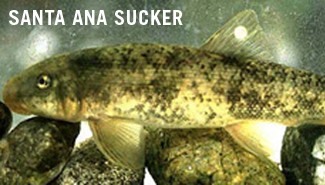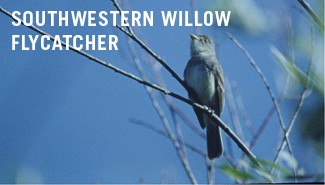
Inland water districts are using unfounded claims, invented projections and a “staged sham” hearing to spread fears to the populace about the U.S. Fish and Wildlife Service (FWS) having designated a portion of the Santa Ana River as a “critical habitat” for a little fish known as the Santa Ana sucker, claims a Los Angeles biologist. By simply following existing law instead of seeking to rewrite it, these same water providers protect the supply that flows down the Santa Ana River to Orange County, explains Illene Anderson, a scientist with the Center for Biological Diversity.
]
As the Weekly has previously reported, the FWS first established a critical habitat area for the Santa Ana sucker in 2005 but was sued two years later by the Center
for Biological Diversity for alleged violations of the
Endangered Specieis Act. So, the federal agency went back to the drawing board and essentially doubled the size of the previous habitat, leading to a lawsuit filed against FWS in August by a dozen inland water agencies serving nearly 3
million Southern California residents.

The back-and-forth culminated in a federal congressional
subcommittee hearing in Highland last week that featured Anderson as a panelist. She maintains in the San Bernardino Sun that a FWS habitat designation under the Endangered Species Act is “routine” and “does not affect
state, county or private parties, but bars federal agencies from harming
the habitat area.”
“There are 642 of them and they protect well over 250 million acres
of land and water spanning every state,” Anderson writes in her op-ed piece. “California has over 100 of them
protecting some 20 million acres of wildlife habitat. If you've driven
to Los Angeles, Palm Springs or San Diego, you passed by, maybe even
through, several federal critical habitat areas. I'm guessing you didn't
even notice.”
Nonetheless, those who attended the Highland hearing were treated to “unprecedented gloom and
doom” about “a
future of catastrophically decreased water supplies and economic
collapse” from “the lopsided panel of handpicked
speakers,” according to Anderson, who claimed a projection that 250,000 acre-feet of water
would be taken away from local water users at a cost of $30 billion over
the next 25 years was totally made up.
She claims actual science went into the newest designation, blaming the previous ineffective one on the Bush administration's FWS. Anderson says the new critical habitat will especially help Orange County water districts that draw from the mighty concrete Santa Ana.
“Everyone that relies on the Santa Ana River for drinking,
recreational and agricultural use can rest assured that water flowing
down the river, supporting Santa Ana suckers, is exactly what we need to
maintain a clean, healthy and reliable water supply for ourselves as
well,” Anderson concludes.
Ironically, officials from the coalition of inland water districts that are suing the FWS is using somewhat the same argument, saying a reduced Santa Ana sucker habitat will ensure clean waters for millions.

Meanwhile, the agencies are bracing for a new Endangered Species Act threat as the FWS proposes doubling critical
habitat for the Southwestern Willow Flycatcher, an endangered bird.
Speaking of birds, Patrick Milligan, president of San Bernardino Valley
Municipal Water District and leader of the coalition of agencies suing the FWS, parrots his Santa Ana sucker objections when saying of the Southwestern Willow Flycatcher, “Just
like we experienced with the Santa Ana sucker, the service doesn't have
the scientific evidence to justify an expansion of critical habitat for
the Southwestern Willow Flycatcher as required by the Endangered
Species Act.” (via Highland News)
My, there sure is a lot of “you-don't-have-the-science-to-back-it-up” talk to this Ping-Pong match, no?
By the way, all of this comes amid the state handing the U.S. Environmental Protection Agency a list of rivers, streams and lakes that are more polluted than previously known. In other words, if Golden State waterways were animals, they would be endangered. And interests on both sides would no doubt sue the government over that.

OC Weekly Editor-in-Chief Matt Coker has been engaging, enraging and entertaining readers of newspapers, magazines and websites for decades. He spent the first 13 years of his career in journalism at daily newspapers before “graduating” to OC Weekly in 1995 as the alternative newsweekly’s first calendar editor.

